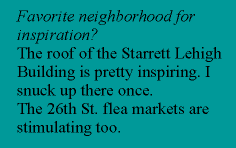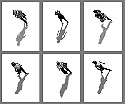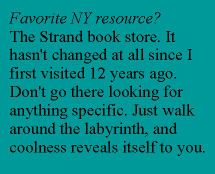 The Online Magazine about New York Designers |
|
|
The Digital Body Builder
LG: You basically have a bed, with an office around it. SE: A lot of my friends laugh at me [about that]. I don't
have a single picture on my wall. My computer equipment, during the
heat of these projects, was spilling out everywhere. I slept right next
to my computer, three workstations at one time. I'm surprised I di LG: We grew up similarly, coming from Queens, moving to Manhattan for art school, and never really living anywhere else. But lately, you've been talking about wanting to go to the country? SE: I have these fantasies of being countrified. However, y'know, for someone who at times can barely expend more energy than a double-click to have food brought to my house…the idea that I would go out and chop wood, is kind of scary. DB: Was your residency at MASS MoCA [two summers ago] like that? (Laughter) SE: Actually, for an artist, it really had the warehouse and abandoned factory appeal. I was a little nervous, about whether I could handle being away from the stimulation, being away from the social life, but it had this sort of "Thoreau" appeal, that I would be in the woods, and I would be in nature, I would be away from the bloody heat. LG: Can you see yourself living that life? |
|
It's another approach to design, about choice and chance. When you are searching for inspirational images, when you're trying to solve a design problem, the web is one way to go: search for WWII helmet, search for "ostrich," and find things in a query manner. But when I go into the Strand [Bookstore], and start to wander around, things start to speak to me. |
||

 dn't
blow out electric sockets in a residential building. In the worst part
of making digital art, you really become a slave to the computer's metabolism,
and you have to be there, when it spits out its result. When I was rendering
huge computer files [through the night], rendering these dancers out,
I would have to wake up – it's almost like flipping burgers at night
– it was like waking up to feed the baby.[You become] a life support
system for these animations.
dn't
blow out electric sockets in a residential building. In the worst part
of making digital art, you really become a slave to the computer's metabolism,
and you have to be there, when it spits out its result. When I was rendering
huge computer files [through the night], rendering these dancers out,
I would have to wake up – it's almost like flipping burgers at night
– it was like waking up to feed the baby.[You become] a life support
system for these animations. 


 r
to work in isolation, and yet you've talked about people forming groups
out there, to counter affect that isolation…
r
to work in isolation, and yet you've talked about people forming groups
out there, to counter affect that isolation…  interaction…
interaction… 